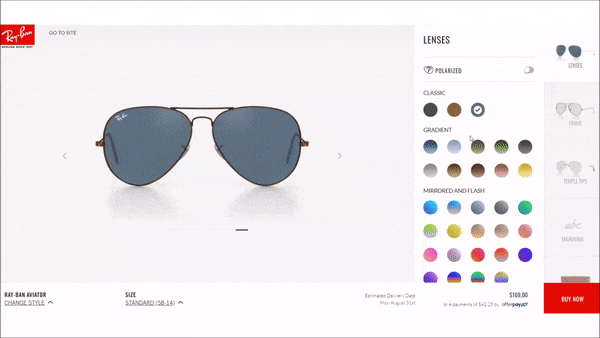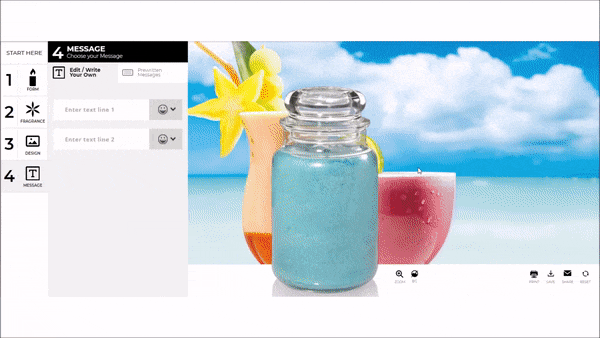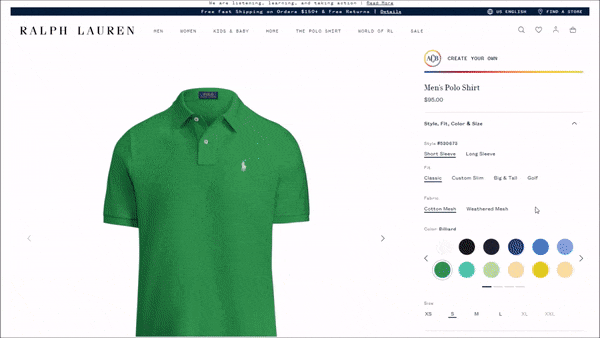
In this blog post, you’ll gain a clear understanding of the differences between product customization and product personalization and learn how to develop a winning strategy for your ecommerce business.
Customizing and personalizing products was once something limited to boutique, luxury brands. The high costs of manufacturing and the truly one-to-one sales process were simply not viable for most retailers.
But today, advancements in manufacturing, ecommerce technology, and product configuration software allow retailers of any size to offer truly unique products to their customers at scale.
These developments have meant that mass customization and mass personalization have become major trends in ecommerce retail over the last several years.
A 2015 Deloitte survey revealed that 36% of consumers expressed interest in personalized products. And of these consumers, 1 in 5 was willing to pay 20% more for these unique products.
A more recent 2019 study by Dassault Systems revealed that consumers are willing to pay 25.3% more for personalized products.
Yet, both of these studies lack precision around the terms personalization and customization as they relate to retail products.
Let’s start with the definitions:
In retail, customization refers to granting your customers the freedom to co-design a product by selecting from a curated set of options.
These can include different colors, patterns, fabrics, materials, and other optional product components.
On the other hand, personalization refers to allowing your customers to add their personal touch to a product.
This encompasses adding personalized text like a monogram or name, user-generated content (UGC) like a personal photo, or selecting graphics from a clip-art library.
Now, let’s look at a few examples to help make the difference between the two a bit more concrete:
Ray-Ban’s Aviator Sunglasses provide a great example of product customization.
This product configurator allows you to customize every element of the sunglasses, including lenses, frame, temple tips, as well as the case.
As a bonus, the configurator also allows you to personalize the sunglasses by adding a monogram to the lenses and the case.

Franklin’s custom Powerstrap baseball gloves provide another highly-engaging example of a customized product.
The Franklin configurator allows you to customize a wide range of glove elements, including colors, textures, and materials.
This highly flexible configurator is perfect for sports teams looking to design unique gloves with their team colors or for an individual baseball player looking to express their style.

Yankee Candle provides a great example of a highly personalized gift.
After customizing the candle shape and fragrance, this configurator allows you to upload a personal image (a.k.a., UGC) or select from a curated gallery of images to be printed on the candle.
You can then add a personal message with text and emojis or choose from a selection of pre-written messages, which can also be personalized.

Ralph Lauren’s custom polo shirts provide another illustrative example of a highly personalizable product.
After selecting your preferred style, fit, color, and size, this configurator allows you to personalize five different areas of the polo.
This includes adding a logo or monogram to the upper left, a flag to the upper right, a vintage year or monogram to the right hem, as well as a name and number to the back of the polo.
With this flexible configurator, Ralph Lauren’s customers can express their personal style through their world-famous polo shirt.

Deciding whether to sell customized products, personalized products, or some combination of the two is not a trivial decision.
Take some time to do your research and come up with a strategy for product customization and personalization that aligns with your business and will provide maximum return on investment (ROI).
Consider these five steps to help develop a winning strategy for your business:
Whether you’re in eyewear, footwear, luxury goods, jewelry, or any other retail sector, it’s vital to stay on top of the latest trends and evolve your products to stay relevant.
Consult top industry publications, the latest industry research reports, and any other relevant sources to identify product trends that could be incorporated into your personalization or customization strategy.
Researching your competitors is another key element of any retail product strategy.
Do your competitors offer customized or personalized products? If so, which of those products are performing the best? Which are not performing as well?
Use this information to determine the types of customization and personalization that will give your brand a clear competitive edge.
There’s no better way to understand what types of customized or personalized products will sell best with your audience than asking them directly!
Put together a targeted market research effort that can include surveys, focus groups, personal interviews, observation, or even field trials of the products.
Be sure your research gauges consumer level of interest, price sensitivity, and preferences for a wide range of relevant customization and personalization options.
Also, strive to understand the practical and emotional motivations that drive purchases. This information will help you define the types of customization and personalization that will best satisfy these needs.
Depending on your current product manufacturing capabilities, you may need to consider investing in new equipment or partnering with a third-party custom manufacturing vendor.
Personalization generally requires techniques like print on demand or embroidery to be applied to standard, non-customized products. These are relatively simple and low cost.
On the other hand, customization typically requires the ability to custom manufacture the products, which can involve higher costs and operational complexity.
Lastly, evaluate how different product customization and personalization approaches will affect other areas of the business. Ask yourself:
Use these questions to help narrow down the types of product customization and personalization that align best with your brand and business goals.
Selling personalized and customized products at scale is a major retail trend that can provide many tangible benefits for your business.
Both types of products can help make your brand stand out from the competition, boost average order value (AOV), and increase brand loyalty.
Whether you choose to offer product personalization, product customization, or both, having a clear, well-researched strategy in place will be key to your success.
To develop this strategy, carefully evaluate your market to understand industry trends, the competitive landscape, as well as consumer preferences and needs. And make sure your approach aligns with the business, fully supporting its growth and financial success.
Interested in implementing product customization or personalization? Request your free demo today to see ConfigureID in action and learn how our platform can take your brand to the next level.